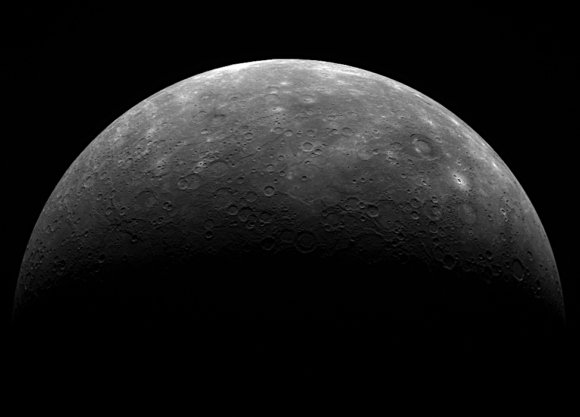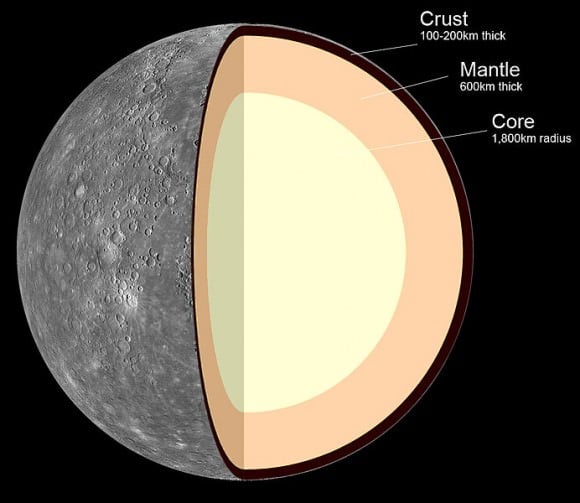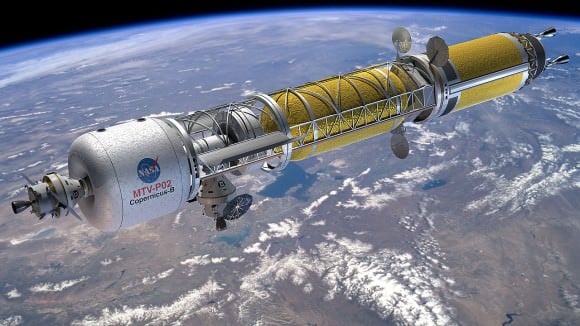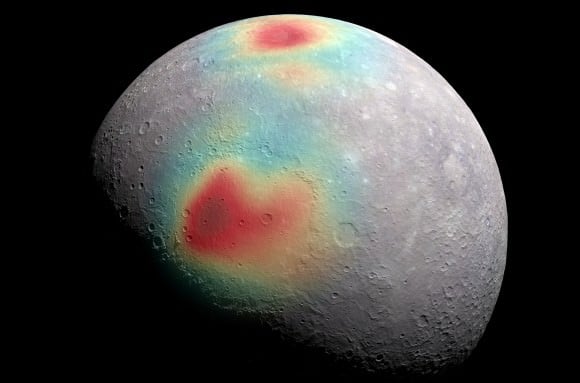Welcome back to another installment in the " Definitive Guide to Terraformin g" series! We complete our tour of the Solar System with the planet Mercury. Someday, humans could make a home on this hostile planet, leading to the first Hermians!
The planet
Mercury
is an intensely hot place. As the nearest planet to our Sun, surface temperatures can get up to a scorching 700 K (427° C). Ah, but there's a flip-side to that coin. Due to it having no atmosphere to speak of, Mercury only experiences intensely hot conditions on the side that is directly facing the Sun. On the nighttime side, temperatures drop to well below freezing, as low as 100 K (-173° C).
Due to its low orbital period and slow rate of rotation, the nighttime side remains in the dark for an extended period of time. What's more, in the northern polar region, which is permanently shaded, conditions are cold enough that water is able to exist there in ice form. Because of this, and a few reasons besides, there are many who believe that humanity could colonize and even terraform parts of Mercury someday.
The Planet Mercury:
With a mean radius of 2440 km and a mass of 3.3022×1023kg, Mercury is the smallest planet in our Solar System – equivalent in size to 0.38 Earths. And while it is smaller than the largest natural satellites in our system – such as Ganymede and Titan – it is more massive.
In fact, Mercury's density (at 5.427 g/cm
3
) is the second highest in the Solar System, only slightly less than Earth's (5.515 g/cm
3
).
Mercury also has the most eccentric orbit of any planet in the Solar System. With an eccentricity of 0.205, its distance from the Sun ranges from 46 to 70 million km (29-43 million mi), and takes 87.969 Earth days to complete an orbit. But with an average orbital speed of 47.362 km/s, Mercury also takes
58.646
days to complete a single rotation. This means that it takes 176 Earth days for the sun to rise and set on Mercury, which is twice as long as a single Hermian year.
[caption id="attachment_110365" align="aligncenter" width="580"]
MESSENGER image of Mercury from its third flyby. Credit: NASA/Johns Hopkins University Applied Physics Laboratory/Carnegie Institution of Washington
[/caption]
As one of the four
terrestrial planets
of the Solar System, Mercury is composed of approximately 70% metallic and 30% silicate material. Based on its density and size, a number of inferences can be made about its internal structure. For example, geologists estimate that Mercury's core occupies about 42% of its volume, compared to Earth's 17%.
The interior is believed to be composed of a molten iron which is surrounded by a 500 – 700 km mantle of silicate material. At the outermost layer is Mercury's crust, which is believed to be 100 – 300 km thick. The surface is also marked by numerous narrow ridges that extend up to hundreds of kilometers in length. It is believed that these were formed as Mercury's core and mantle cooled and contracted at a time when the crust had already solidified.
Mercury's core has a higher iron content than that of any other major planet in the Solar System, and several theories have been proposed to explain this. The most widely accepted theory is that Mercury was once a larger planet which was struck by a
planetesimal
that stripped away much of the original crust and mantle, leaving behind the core as a major component.
Another theory is that Mercury formed from the solar nebula before the Sun's energy output had stabilized, and was twice its present mass. However, most of this mass was vaporized as the protosun contracted and exposed it to extreme temperatures. A third hypothesis is that the solar nebula caused drag on the particles from which Mercury was accreting, which meant that lighter particles were lost and not gathered to form Mercury.
[caption id="attachment_121677" align="aligncenter" width="580"]
Internal structure of Mercury: 1. Crust: 100–300 km thick 2. Mantle: 600 km thick 3. Core: 1,800 km radius. Credit: MASA/JPL
[/caption]
At a glance, Mercury looks similar to the Earth's moon. It has a dry landscape pockmarked by asteroid impact craters and ancient lava flows. Combined with extensive plains, these indicate that the planet has been geologically inactive for billions of years. However, unlike the Moon and Mars, which have significant stretches of similar geology, Mercury's surface appears much more jumbled.
The vast majority of Mercury's surface is hostile to life, where temperatures gravitate between extremely hot and cold – i.e. 700 K (427 °C; 800 °F) 100 K (-173 °C; -280 °F). This is due to its proximity to the Sun, the almost total lack of an atmosphere, and its very slow rotation. However, at the poles, temperatures are consistently low -93 °C (-135 °F) due to it being permanently shadowed.
In 2012, NASA's MErcury Surface, Space ENvironment, GEochemistry, and Ranging (
MESSENGER
) probe
detected signs of water ice
and organic molecules in Mercury's northern polar region. For over twenty years, scientists had suspected that in this area, Mercury's craters could contain ice that was most likely deposited by comets in the past. Radar signals appeared to confirm as much, but it took the
MESSENGER
mission to confirm it.
Scientists believe that Mercury's southern pole may also have ice. All told, it is estimated that Mercury could hold between 100 billion to 1 trillion tons of water ice at both poles, and the ice could be up to 20 meters deep in places. In the north pole, this water is particularly concentrated in craters like the Tryggvadottir, Tolkien, Kandinsky, and Prokofiev craters - which measure between 31 to 112 km in diameter.
In addition, the
MESSENGER
mission also noted the presence of
"hollows" on Mercury's surface
which appeared to reach underground. Similar to hollows observed on
the Moon
and
Mars
, these features could be indicative of lava tubes that were formed during Mercury's volcanically-active past. In both of these cases, stable lava tubes are seen as a possible location for colonies that would be shielded from radiation, space, and other hazards.
Possible Methods:
While terraforming an entire planet like Mercury is not exactly practical, its subsurface geology, cratered surface, and orbital characteristics make colonizing and terraforming some parts of it attractive. For example, in the northern polar region, where permanently-shadowed craters house water ice and organic molecules, domed structures could be set up that would allow any atmosphere created within to be contained.
This is a variation on the "
Shell Worlds
" concept, which in turn is part of the larger concepts known as paraterraforming - where a world is enclosed (in whole or in part) in an artificial shell in order to transform its environment. Using this process, the northern craters could be enclosed within a dome, orbital mirrors could focus sunlight within the domes, and the water ice could be evaporated.
Through the process of photolysis, the water vapor could be converted into oxygen gas and hydrogen, the latter of which could either be harvested as fuel, or vented into space. Ammonia could also be introduced, most likely mined from the outer Solar System, and converted into nitrogen gas through the introduction of specific strains of bacteria
- Nitrosomonas,
Pseudomonas
and
Clostridium
species – that would convert the ammonia into nitrites (NO²-) and then nitrogen gas.
[caption id="attachment_117903" align="aligncenter" width="580"]
A forced perspective view of Mercury's north pole. Credit: NASA/Johns Hopkins University Applied Physics Laboratory/Carnegie Institution of Washington
[/caption]
Lava tubes on Mercury could similarly be colonized, with settlements built within stable ones. These areas would be naturally shielded to cosmic and solar radiation, extremes in temperature, and could be pressurized to create breathable atmospheres. In addition, at this depth, Mercury experiences far less in the way of temperature variations and would be warm enough to be habitable.
Potential Benefits:
Mercury's relative proximity to Earth makes it a good location for terraforming and colonization. On average, Mercury is 77 million km (48 million miles) from Earth. To put that distance in perspective, it took the
*Mariner 10*
probe (which took a much more direct route than
MESSENGER
) took a little under five months to reach Mercury from Earth.
Colonies established on Mercury would also be in a good position to provide extensive minerals and solar power to other planets. As the second-densest planet in the Solar System, Mercury has an abundance of iron, nickel and silicate minerals that would be of use locally and elsewhere. Also, its proximity to the Sun means that solar operations, possibly in the form of space-based solar arrays, could harness abundant energy.
This energy could then be beamed to other worlds for local use. Solar wind also adds hydrogen and helium to the planet's exosphere, while radioactive decay within its crust is an additional source of helium. These could also be mined to create hydrogen fuel and helium-3, both of which could be used to power fusion reactors both on and off-planet.
[caption id="attachment_91559" align="aligncenter" width="580"]
NASA's Mariner 10 space probe, which conducted flybys of Venus and Mercury in the 1970s. Credit: NASA
[/caption]
As a result, colonies on Mercury, thanks to the abundance of water ice, minerals and other elements, would likely be largely self-sufficient as well. Unlike other potential sites that would require the importation of vast amounts of resources, Mercury's first wave of colonists (aka. Hermians) could begin to see to much of their own needs shortly after setting down.
Potential Challenges:
As always, the prospect of terraforming Mercury presents several challenges, an addressing one requires that others be addressed simultaneously. Fortunately, compared to many other planets (or moons) in the Solar System, they are fewer in number. In short, the challenges come down to issues of distance, technology, resources and infrastructure, and natural hazards.
To address the first, travel to and from Mercury would still take a significant amount of time using existing technology. While closer than many other potential sites, several trips would need to be made by crewed spacecraft, construction ships and support craft, which would take time and cost quite a lot using existing technology. In addition, hauling resources from the outer Solar System would take on the order on decades using the conventional engines and spacecraft.
Which brings us to item two: technology. In order for ships to travel to and from the outer Solar System to procure ammonia and other volatiles in large quantities (and in a reasonable amount of time), they would need to be equipped with advanced propulsion systems to make the journey. This could take the form of
Nuclear-Thermal Propulsion
(NTP),
Fusion-drive systems
, or some other
advanced concept
. But thus far, no such drive systems exist, with some being decades or more away from feasibility.
[caption id="attachment_118441" align="aligncenter" width="580"]
Artist's concept of a Bimodal Nuclear Thermal Rocket in Low Earth Orbit. Credit: NASA
[/caption]
As for the next item, resources and infrastructure, colonizing and paraterraforming Mercury would require plenty of both. To start, it would take an immense amount of minerals and other materials to construct domes large enough to encase any of Mercury's polar craters. Building orbital mirrors would be similarly be taxing. And while these minerals could be harvested locally, the process would be very expensive.
Similarly, the technology behind
space-based solar power
is not even close to where it would need to be harvest energy from the Sun and beam it directly to Earth (or other locations across the Solar System). Here too, the technology needs to come a long way; and even after we have that worked out, creating such a network between Mercury and other planets would be very expensive.
At the same time, it would require a level of infrastructure that also does not yet exist. Aside from a large fleet of spacecraft to ferry colonists, settling Mercury would also require a significant amount of construction vessels and automated robots. We would also need a series of stations between Earth and Mercury to provide for refueling and resupply.
And last, any construction and settlement efforts would have to deal with the dangers of exposure to extreme heat and Solar radiation. While a colony in the northern polar region and within Mercury's lava tubes would be shielded, labor crews and construction ships would have to risk working in extremely hazardous conditions in order to build them.
[caption id="attachment_126320" align="aligncenter" width="580"]
Gravity anomalies on Mercury—mass concentrations (red) suggest subsurface structure and evolution. Credit: NASA/Goddard/Johns Hopkins/Carnegie Institution of Washington
[/caption]
Conclusion:
In the end, and compared to other terraforming ventures, the colonization and paraterrforming of Mercury does seems rather doable. While it would require a huge commitment in terms of resources, the creation of technology and infrastructure that does not yet exist, and some serious hazard pay for the work crews who would assemble the Hermian settlements, the advantages could be enough to justify such an undertaking.
A colonized Mercury would mean abundant minerals and energy for the rest of the Solar System. Having these resources at our fingertips would be intrinsic to creating a post-scarcity economy, and could speed the development of colonies and terraforming efforts elsewhere.
We have written many interesting articles about Mercury and terraforming here at Universe Today. Here's
The Planet Mercury
,
The Definitive Guide to Terraforming
,
How Do We Terraforming Mars?
,
How Do We Terraform Venus?
,
How Do We Terraform the Moon?
,
How Do We Terraform Jupiter's Moons?
, and
How Do We Terraform Saturn's Moons?
We've also got articles that explore the more radical side of terraforming, like
Could We Terraform Jupiter?
,
Could We Terraform The Sun?
, and
Could We Terraform A Black Hole?
Astronomy Cast also has a good episode on the subject,
Episode 49: Mercury
And if you like the videos, come check out our
Patreon page
and find out how you can get these videos early while helping us bring you more great content!
 Universe Today
Universe Today






